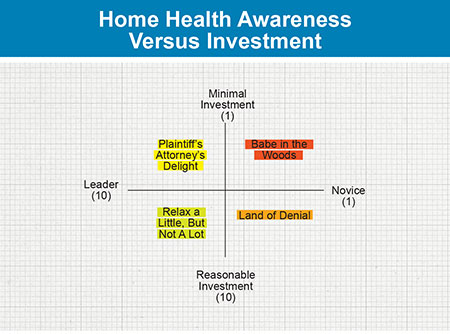
Is your homecare agency positioned for a boom or destined for a bust? How ready are you to meet the highest priority requirements by the end of the year 2023, as targeted by a survey of your peers at the January 2020 Care Coordination Technology Healthcare Summit? Winners of the race to better value-based patient care will reap true competitive advantages; unfortunately, losing organizations may not survive.
This article expands on the information in “How to Evaluate and Improve Your 2023 Patient Outcomes” from HomeCare’s August 2019 issue and the June 2020 follow up, “3 Priorities to Focus on as You Prepare for the Future.” Regardless of all the inevitable distractions—including and especially COVID-19—standing still is not an option when you face the hindsight judgments of an ever-growing group of second guessers.
In 2019, a 2023 deadline from your peers would have seemed an eternity away. But these insights offered a rare opportunity for well-positioned, well-led organizations to lap the competition and seize the lead in value-based patient care. You will soon get your 2023 boom-or-bust grade.
Boom or Bust?
If you boom, Your agency gets the improved patient outcomes you wanted when you chose a career in health care. Mandated improvements are methodically and relentlessly driving improved patient care. If you boom, patients will choose your agency for better, less-expensive care. You’ll retain medical staff, and you can poach workers from competitors who are falling short. You will be able to negotiate better contracts with non-Medicare payers. These are the outcomes your stakeholders expect.
A bust can involve a failure to meet expected scores on patient quality outcomes, plus the related financial incentives and penalties. This could lead to an organization going out of business, being acquired or falling dramatically behind as patients move to better-ranking competitors. At a minimum, your patients will migrate to where they get better-quality care for less money, your best staff will move to where they have better tools to serve health care needs, and you may lose out on entry into payer networks.
Avoiding the Bust
As always on crucial, yet nonurgent issues, people normally fall into three categories: strategic-thinking leaders; leaders driven by the crisis of the moment, with different agendas or underfinanced organizations; and procrastinators. Let’s look at how you can easily evaluate where you are, where you want to be and what options you can create for your agency.
This article will focus on three key points that will help agency owners tackle the top areas of concern for the 2023 target:
- The suggested procedures and policies you need to have in place and in practice by year-end 2023;
- Where you stand on those objectives today; and
- How you can you create options now—plus which of the three areas of concern you should primarily focus on to get as close to those 2023 targets as possible.
Top 3 Areas of Concern for 2023
Participants at the 2020 Care Coordination Technology Healthcare Summit suggested three crucial areas where most organizations need to significantly improve:
- Increased “hospital-at-home” and virtual care availability for longer periods
- Improved “build-versus-buy options” to reduce departmental silos and islands of data
- Expanded focus on the social determinants of health (SDOH)
Where You Stand
Using this two-minute exercise, assess where your organization is today in each of the three critical areas, and then where you need to be by 2023. To provide a tool for that evaluation, I updated the Home Health Awareness versus Investment process and four quadrant visual
1. Mark your answers for each area on the two axes in the graphic.
For “Awareness,” rate your organization on the horizontal continuum from Leader to Novice (one to 10, where one means your head is in the sand, and 10 means you are ahead of schedule and building in a margin of error). Then do the same for “Investment,” marking your answer on the vertical continuum from reasonable investment to minimal investment.
Draw a line between these two points to spotlight your current position and suggest where to begin your strategic review.
2. Rinse & repeat.
For each of the three areas, repeat the steps above and determine what quadrant status you can reasonably achieve by the end of 2023.
3. Calculate your current status versus your end of 2023 requirements.
Acknowledge this status to top management and your board of directors, and begin moving toward your new targets for value-based delivery.
If you are one of the fortunate few whose knowledge and actions have put you well ahead in addressing risks and opportunities, use these steps to determine your present situation and unearth your next opportunity. If you are not so lucky, consider how you can best move forward. Whatever your position, you now have an estimate of your 2023 ranking—and you have pinpointed the most crucial improvements needed.
Finally, to help you get moving, consider the following next steps based on where your organization ranked on the 1–10 scale described above:
1–2: If you haven’t even started, you will be ruthlessly second guessed, probably well before 2023. Take some baby steps and regroup.
3–6: If you have started but probably won’t get there without investing additional resources of people and money, get your sponsor or advocate more deeply involved or get external expert support.
7–10: If you are well under way, keep the pedal to the metal. Someone will be the winner in providing better patient support, and they will have the ability to exploit their hard work and leadership to acquire the laggards’ best people, patients or even their organizations. Why not be that winner?

Take Your Medicine
Tough news is never easy to give or receive. Nor is cod liver oil easy to take, Vicks VapoRub easy to apply or a healthier diet easy to maintain. But the benefits explain why those products and services sell year after year. Personally, none of those are my favorites. Yet depending on the year, how bad I feel or what my medical experts tell me to do, I take those unpleasant yet appropriate prescriptions.
You still have time to get started on the effective improvements that need to be in place by 2023. Take advantage of your limited time rather than procrastinating. Your actions will benefit your patients as well as your organization (and maybe even save your job or the job of a colleague).
Remember that standing still is not an option: You can dodge the bust by avoiding inertia. Keeping your focus on the three top issues above, make sure your organization will be well positioned to meet the increased demands of 2023—and be rewarded with a boom.
